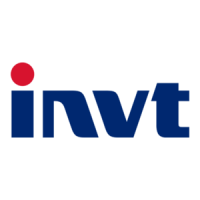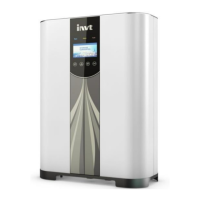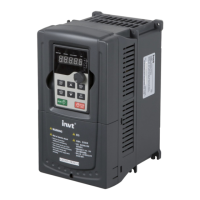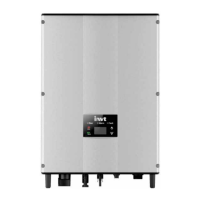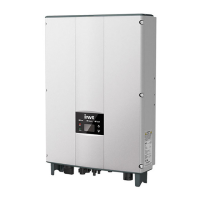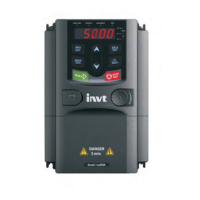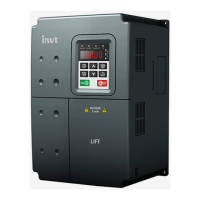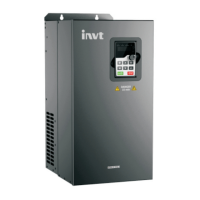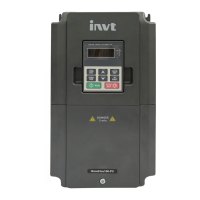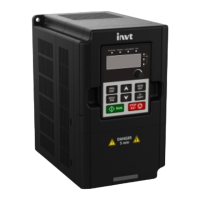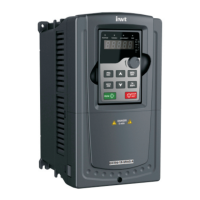What to do if my INVT Inverter displays UV?
- WWesley CollinsSep 7, 2025
If your INVT Inverter displays 'UV', it is because the voltage is too low. Inspect the input power supply.
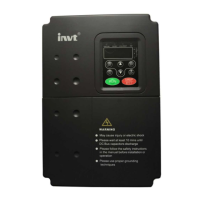
 Loading...
Loading...
What to do if my INVT Inverter displays UV?
If your INVT Inverter displays 'UV', it is because the voltage is too low. Inspect the input power supply.
What does CE error mean on INVT Inverter?
If your INVT Inverter displays 'CE', it could be caused by an improper baud rate setting (select proper baud rate), receiving wrong data (press STOP/RST to reset and ask for support), or communication being interrupted for a long time (check communication devices and signals).
What to do if my INVT CHV180-004G-4 Inverter shows ITE error?
If your INVT Inverter displays 'ITE', it could be due to loose wires or connectors on the control board (check the connector and rewire), a damaged assistant circuit (ask for support), a damaged Hall sensor (ask for support), or an abnormal amplifying circuit (ask for support).
Why does my INVT CHV180-004G-4 trip the input switch when running?
If your INVT Inverter displays 'The inverter displays normally when power on, but switch at the input side trips when running', inspect whether the output side of inverter is short circuit. If yes, ask for support. Inspect whether ground fault exists. If yes, solve it. If trip happens occasionally and the distance between motor and inverter is too far. It is recommended to install output AC reactor.
What should I do if my INVT CHV180-004G-4 Inverter is running but the motor won’t move?
If your INVT Inverter displays 'Motor doesn’t move after inverter running', inspect if there is balanced three-phase output among U, V, and W. If yes, then motor could be damaged, or mechanically locked. Please solve it. If the output is unbalanced or lost, the inverter drive board or the output module may be damaged. ask for support.
Why does the INVT CHV180-004G-4 Inverter trip the power supply when turned on?
If your INVT Inverter displays 'Power supply air switch trips off when power on', inspect whether the input power supply is grounded or short circuit. Please solve the problem. Inspect whether the rectify bridge has been burnt or not. If it is damaged, ask for support.
How to troubleshoot no display on INVT CHV180-004G-4 Inverter after power on?
If your INVT Inverter displays 'No display after power on', inspect whether the voltage of power supply is the same as the inverter rated voltage or not with multi-meter. If the power supply has problem, inspect and solve it. Also inspect whether the three-phase rectify bridge is in good condition or not. If the rectification bridge is burst out, ask for support. Check the CHARGE light. If the light is off, the fault is mainly in the rectify bridge or the buffer resistor. If the light is on, the fault may be lies in the switching power supply. Please ask for support.
What does OUT1 error mean on INVT Inverter?
If your INVT Inverter displays 'OUT1', it may be due to the Acc/Dec time being too short (increase Acc/Dec time), an IGBT module fault (ask for support), malfunction caused by interference (inspect external equipment and eliminate interference), or improper grounding.
What to do if INVT CHV180-004G-4 Inverter displays OL2?
If your INVT Inverter displays 'OL2', it could be caused by a short Acc time (increase Acc time or select a bigger capacity inverter), restarting the rotating motor (avoid restarting after stopping), low input voltage (select a bigger capacity inverter), or an excessively heavy load.
What does OV1 error mean on INVT CHV180-004G-4 Inverter?
If your INVT Inverter displays 'OV1', it could be due to abnormal input voltage (check the input power) or restarting the rotating motor after a sudden power off (avoid restarting after stopping).
Details the layout and function of main circuit and control terminals.
Provides a comprehensive wiring diagram for system setup.
Covers connections for power supply, motor, and braking units.
Provides guidelines for proper installation to ensure electromagnetic compatibility.
Explains the functions of the inverter's keypad buttons and indicators.
Details procedures for parameter setting, fault reset, and autotuning.
Configures fundamental inverter settings like speed control mode and run command source.
Adjusts acceleration, deceleration, and multi-step speed settings for smooth operation.
Sets motor-specific parameters for optimal performance and autotuning.
Optimizes vector control performance with PI loop and filter settings.
Configures various protection features like phase-failure and overload protection.
Provides a table of fault codes, types, reasons, and solutions for diagnosing issues.
Discusses common operational faults like no display, motor not moving, and tripping.
Guides on setting parameters, debugging, autotuning, and S-curve adjustment.
Configures fundamental inverter settings like speed control mode.
Adjusts acceleration, deceleration, and multi-step speed settings.
Sets motor-specific parameters for optimal performance and autotuning.
Optimizes vector control performance with PI loop and filter settings.
Configures various protection features like phase-failure and overload protection.
